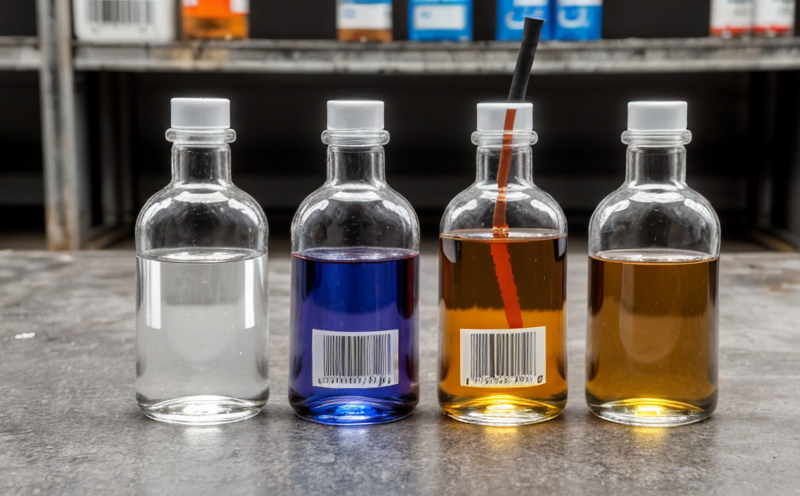DIN EN ISO 12543 Glass Interlayer Stability Testing
The DIN EN ISO 12543 standard is specifically designed to evaluate the stability and degradation of glass interlayers, which are crucial components in safety glazing products such as laminated windscreens, windshields, and safety glass. This standard ensures that these materials meet stringent durability requirements under various environmental conditions, including temperature cycling, humidity exposure, and UV radiation.
The testing process involves exposing the glass interlayer to controlled environmental factors over a specified period to assess its resistance to physical and chemical changes. The primary focus is on identifying any signs of degradation or deterioration that could compromise the structural integrity of the product. This includes checking for embrittlement, discoloration, loss of adhesion between layers, or other defects.
Specimen preparation is critical in this testing procedure. Samples are typically cut to standard dimensions and conditioned under specified temperature and humidity conditions before being subjected to environmental stress tests. The choice of specimen size and shape can significantly influence the results, so it’s important to follow the guidelines outlined in DIN EN ISO 12543.
Instrumentation used for this testing includes environmental chambers that can precisely control temperature, humidity, and UV exposure levels. These controlled environments allow for accurate replication of real-world conditions that glass interlayers might encounter during their lifecycle. The use of advanced spectroscopic techniques helps in monitoring changes in the chemical composition of the interlayer over time.
Acceptance criteria are strictly defined according to DIN EN ISO 12543, ensuring consistency across different laboratories and test facilities. Compliance with these criteria is essential for manufacturers aiming to ensure product quality and safety. Failure to meet the specified acceptance limits can lead to potential failures in end products, posing risks to consumer safety.
The results of this testing are critical for regulatory compliance and market acceptance. By adhering to DIN EN ISO 12543 standards, companies demonstrate their commitment to producing high-quality, reliable glass interlayers that meet international standards. This not only enhances product reputation but also facilitates easier market access in various regions.
In conclusion, the importance of DIN EN ISO 12543 cannot be overstated for manufacturers involved in the production of safety glazing products. Proper implementation ensures robust performance and longevity of these materials under diverse environmental conditions, thereby enhancing overall product reliability and consumer confidence.
Why It Matters
The stability and degradation testing of glass interlayers is pivotal for ensuring the integrity and safety of laminated safety glazing products. These tests are essential because they help identify any potential weaknesses or vulnerabilities in the materials that could lead to product failure under real-world conditions. By conducting rigorous assessments, manufacturers can anticipate issues early on and implement necessary improvements.
For quality managers and compliance officers, these tests provide critical data for decision-making processes related to product development and certification. Ensuring compliance with international standards like DIN EN ISO 12543 not only enhances the reputation of the products but also streamlines the process of market entry in various regions. This is particularly important given the growing demand for safer, more reliable glass interlayers.
R&D engineers benefit from this testing by gaining insights into how different environmental factors affect the performance of glass interlayers. Understanding these effects allows them to innovate and develop new materials that can withstand harsher conditions without compromising on quality or safety. This knowledge is invaluable in advancing technology and improving product design.
Procurement teams also find value in this testing process as it helps them select suppliers who adhere strictly to international standards. By sourcing from reputable vendors, they ensure the procurement of high-quality materials that meet stringent requirements, thus reducing the risk of substandard products reaching the market.
Benefits
The benefits of conducting DIN EN ISO 12543 glass interlayer stability testing are manifold. Firstly, it provides manufacturers with comprehensive data on how their materials perform under various environmental conditions. This information is invaluable for optimizing production processes and improving product quality.
Secondly, compliance with international standards enhances the reputation and credibility of the products in both domestic and international markets. It also facilitates easier market access by meeting regulatory requirements in different regions.
Thirdly, the testing process helps identify potential issues early on, allowing manufacturers to address them before they escalate into larger problems. This proactive approach ensures that products are reliable and safe throughout their lifecycle.
Furthermore, conducting these tests demonstrates a company’s commitment to quality and safety, which is increasingly becoming a key factor for consumers when making purchasing decisions. It also builds trust with regulatory bodies and other stakeholders involved in the industry.
In addition, the results of this testing are often used as evidence during audits or inspections conducted by regulatory authorities. This not only ensures that manufacturers remain compliant but also provides peace of mind knowing that their products meet stringent quality standards.
The overall benefit of DIN EN ISO 12543 glass interlayer stability testing lies in its ability to provide robust, reliable data that supports informed decision-making throughout the product lifecycle. By leveraging this information, companies can continuously improve their offerings and maintain a competitive edge in the market.
International Acceptance and Recognition
- DIN EN ISO 12543 is widely recognized and accepted across Europe as a standard for assessing the stability of glass interlayers.
- The United States has also adopted this standard, integrating it into its own regulatory frameworks to ensure consistent quality standards.
- Other countries around the world are increasingly adopting similar standards to enhance product safety and reliability.
This widespread acceptance highlights the importance of adhering to international standards for glass interlayer stability testing. By following these guidelines, manufacturers can ensure their products meet global expectations and gain broader market access.





